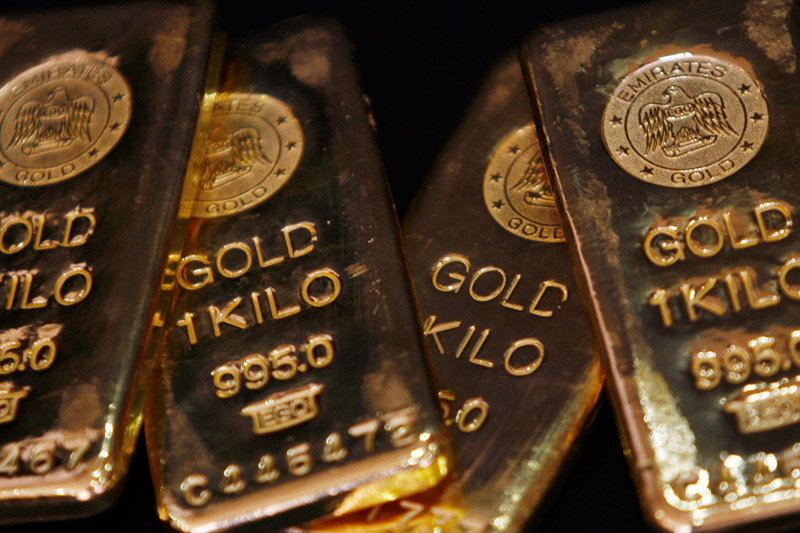Investing.com - Gold prices declined on Friday, after a number of upbeat U.S. economic reports suggested that economic growth regained speed in the second quarter.
Gold for August delivery on the Comex division of the New York Mercantile Exchange shed $4.80, or 0.36%, to settle at $1,327.40 a troy ounce by close of trade.
Prices of the yellow metal turned slightly higher in post-settlement trade after news broke of an apparent military coup in Turkey. But the coup attempt crumbled as President Recep Tayyip Erdogan rushed back to Istanbul from a Mediterranean holiday and urged people to take to the streets in support of his government against plotters he accused of trying to kill him.
Earlier, gold fell to the lowest levels of the session after data showed that U.S. retail sales rose more than expected in June, as Americans bought motor vehicles and a variety of other goods, bolstering views that economic growth picked up in the second quarter.
Those expectations were further reinforced by other data on Friday showing that industrial production recorded its biggest increase in 11 months in June, driven by a surge in motor vehicle assembly. With domestic demand strengthening, inflation is also steadily rising.
The bullish data could allow the Federal Reserve to raise interest rates later this year, but much will depend on policymakers' assessment of the impact on the U.S. economy of Britain's June 23 vote to leave the European Union.
Three Federal Reserve policymakers on Thursday expressed the view that there was no hurry to raise U.S. interest rates in the wake of the U.K. decision to leave the European Union, despite signs that the U.S. economy is near full employment.
Interest rate futures are currently pricing in a 43% chance of a rate hike by December. Gold is sensitive to moves in U.S. rates. A gradual path to higher rates is seen as less of a threat to gold prices than a swift series of increases.
For the week, gold futures slumped $45.20, or 2.22%, the first weekly loss in seven weeks, as uncertainty around the implications of Britain's Brexit vote eased with the formation of a new government.
Prices surged to a more than two-year high of $1,377.50 earlier this month, as concerns surrounding global growth in wake of Britain’s vote to exit the European Union sent investors flooding into safe haven assets.
Gold is up nearly 25% so far this year, drawing support from fading expectations of a Fed rate hike and as expectations mounted that central banks around the world will step up monetary stimulus to counteract the negative economic shock from the Brexit vote.
Expectations of monetary stimulus tend to benefit gold, as the metal is seen as a safe store of value and inflation hedge.
Also on the Comex, silver futures for September delivery shed 15.7 cents, or 0.77%, on Friday to settle at $20.16 a troy ounce. On the week, silver futures tacked on 24.5 cents, or 0.33%, the seventh consecutive weekly gain.
Elsewhere in metals trading, copper for September delivery dipped 0.9 cents, or 0.42%, on Friday to end at $2.233 a pound. For the week, New York-traded copper prices surged 9.1 cents, or 5.29%, amid optimism stimulus will be unleashed in some of the world’s leading economies.
China's economy grew 6.7% in the second quarter from a year-ago, unchanged from the first quarter, data showed on Friday. Analysts had expected it to dip to 6.6%.
Also in China, fixed asset investment rose 9.0%, less than the 9.4% year-on-year gain seen in June, while industrial production gained 6.2%, better than 5.9% seen in the same period and retail sales rose 10.6%, a tad better than 10.0% seen.
The Asian nation is the world’s largest copper consumer, accounting for nearly 45% of world consumption.
In the week ahead, market players will be focusing on the outcome of Thursday’s European Central Bank meeting to see if policymakers will step up monetary stimulus to counteract the negative economic shock from the Brexit vote.
Investors will also be looking to Friday’s survey data on euro zone business activity, as well as a report on German business confidence, for fresh indications on the health of the region’s economy in wake of Britain's vote to exit the European Union.
Meanwhile, the U.K. will stay in the spotlight as key economic indicators for the British economy are released.
In the U.S., investors will eye a pair of reports on the housing sector to gauge if the world's largest economy is strong enough to withstand further rate hikes in 2016.
Ahead of the coming week, Investing.com has compiled a list of significant events likely to affect the markets.
Monday, July 18
Markets in Japan will be closed for a national holiday.
Tuesday, July 19
The Reserve Bank of Australia is to publish the minutes of its latest monetary policy meeting, giving investors insight into how officials view the economy and their policy options.
The U.K. is to publish data on consumer price inflation.
In the euro zone, the ZEW Institute is to report on German economic sentiment.
The U.S. is to release reports on building permits and housing starts.
Wednesday, July 20
The U.K. is to publish the monthly employment report.
Thursday, July 21
The U.K. is to produce figures on retail sales and public sector borrowing.
The ECB is to announce its monetary policy decision. The rate announcement will be followed by a post-policy meeting press conference with President Mario Draghi.
The U.S. is to release data on jobless claims, existing home sales and manufacturing activity in the Philadelphia region.
Friday, July 22
The euro zone is to release data on private sector business activity.
The U.K. is to release survey data on activity in the manufacturing sector.
Canada is to round up the week with data on retail sales and consumer inflation.
